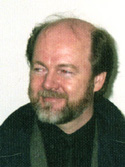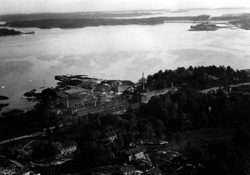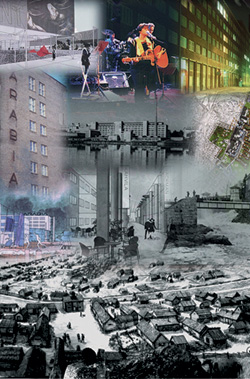
| ||||
Presentation
|
|
|
 Foreword ForewordThis text is based on a presentation held during a symposium in the wonderful town of Matsuzaki-Cho, on a beautiful spring day full of cherry flowers, the 5th of April in 2001. It concentrated mostly into the Arabia Development Project in Helsinki. Due to my minor experiences of the Japanese town it is extremely difficult to conclude any comparison between Japan and Finland. The differences lie in cultural identities reflected in the built environment, the varying societal processes that deal with urban development, and values carried on buy individuals while making decisions. Thus the only alternative was to focus on features that may be of general interest or just descriptive of the unique situation in Arabia Waterfront in Helsinki. The short time available allowed only outlining the situation in Arabia area and describing the rough principles of Finnish urban planning. Anyhow, despite of the obvious differences in urban logic, it is extremely interesting to expose the various ways of cultural transfer, how people guide the formation of the physical environment in their communities, how they meet the challenges, the strengths and weaknesses of the existing society in the context of future.
Old town
 Background BackgroundWith the order of King of Sweden, Kustaa Vaasa, Helsinki was founded in 1550 in proximity of an area presently called Arabia, into the mouth of River Vantaa, a beautiful place with rapids, rocks, large areas for migrating birds and the river meeting the sea. At the time Helsinki was practically a small village with just a handful of families. In about 100 years the inhabitants moved away, further down the coastline. Along with the industrialization of the society the waterfronts in general began to attract factories and storage functions, accessible through the waterways. The first one taking a location in Arabia was the "Old Broadcloth Factory" in 1847. It started an industrial activity, which is still going on. One of the first and best known factories, the Arabia porcelain factory is still going strong while many others have moved or finished and been replaced by new industry or production. This actually is quite reflective of the general situation in the country. The old waterfront building complexes have become empty of their original functions. The condition creates problems, as well as, new challenges and possibilities for the city to seek for interventions and densification of the downtown edges. The area is located in the middle of a natural landscape, a "green necklace" of Eastern Helsinki waterfront. On the other hand there is a notion of the situation of Arabia as a link in the metropolitan chain of centers of expertise. They reach out from Helsinki University of Technology in Otaniemi in the West, Helsinki University in the center of Helsinki, University of Art and Design in Helsinki in Arabia and finally the biological research center in Viikki, Northwest of Arabia. The reason to present this case in the symposium is the fact that the new town will be built around the University of Art and Design. It gives a rarely experienced opportunity to profile the contents of the town accordingly.
Arabia poster
 Urban Planning in Finland Urban Planning in FinlandIn Finland planning is the monopoly of the municipality even though the land may be owned by private, as well as, public organizations, individual people etc. The planning process, however, is under careful democratic control and subject to decisions by the municipal democratic bodies. Basically the plans form a hierarchical system of a regional plan, master plan, a zoning plan and often architectural design outlines for the close environment. The quality and type of building is also regulated through a Municipal Building Order and State standards. The architectural design is submitted to building inspection and only after the permit can the construction work be done. Normally the initiative for planning come from the municipality itself but increasingly it tends to follow the initiative of a private landowner and quite often the motive is merely private speculation. Or it may be a public housing organization, based on a housing policy or an economical development policy. Arabia Development Plan and the Process Arabia project differs radically from the national, normal planning frame. It is reasonably rare even globally. Although the planning process itself follows the law formally, it has been added with several elements that secure and promote the initial intentions. The objective to develop the area is fundamentally culturally oriented, not based on speculation or housing policies. All the other aspects are dominated by this cultural orientation. The original initiative was to create a center of expertise in media and design. Since the beginning the vision has grown and covers art and housing, as well. The population is supposed to reflect a vast diversity of social groups. The area will also be organically linked with the city center. The inner archipelago, the nearness of a natural reserve and a bird refuge are a treasure that has to be cherished. Accordingly the planning process has included an exceptionally careful study of the natural conditions. The conclusions have been transferred into the city plan unconditionally. The timetable for the implementation is expected to be 12 years. As a result there will be 7000 new inhabitants, 5000 new jobs and 200 new companies in the area.
Arabia Development Plan
 Processual Elements Processual ElementsThe process is supported by several elements of promoting, advancing and creating innovative contents to the execution of the plans. Since Helsinki City owns most of the land, the construction project organization of the area is taken care by the city administration. The ownership gives the municipality an instrument of ruling conditions into the agreements, with which it hands the sites to different clients, developers etc. One of beautiful conditions is the principle of 2 % of the building costs that have to be invested in art or design. Another one is that the sites will subject to competition. The rivaling contractors or other clients have to compete either about architecture or other innovative ideas concerning their building project. The site will be given to the one who presents the best proposal. There is also an art coordination project to connect artists, designers, architects and operators of the area, to bring the expertise into the real environment. In addition to that the key players in the area - e.g. the university - have established a mutual development company, ADC Helsinki, to take care of creating and coordinating intelligent infrastructure, high-class information network, operational innovative patterns and services. Future Home Research and Development Program carries out research related to questions about living in a home in the future. The multidisciplinary and crossover structure of the program ensures that the devoted partners in the various projects of the program will transfer the research results into reality. DESIGNIUM is established to transfer design into production. ARABUS, a specialized business incubator guides and houses emerging enterprises to assist them in turning their know-how into a enterprises. Elements of Content In the new setting the educational institutions become a new kind of a cultural center, which involves and activates the inhabitants of the area in production and consumption of culture. The university already houses an outstanding Media center called LUME. Close to the university are the Audiovisual College and Audiovisual Vocational School. The Pop-Jazz College is already an old resident in Arabia and offers a audible addition to the soundscape of the area. Other existing cultural functions and great attractions to visitors are the Museum of Technology and The Museum of Arabia Factory. Future prospects are the Museum Center and a mutual library with collections of at least the municipality and the university. The productive core of the area will consist of the numerous innovative companies that represent different disciplines art, media and design. Tens of them already exist in the area.
University
 Conclusions and Results Conclusions and ResultsThe results of the construction phase will be visible within 12 years. It will thrilling to follow the construction but it is even more interesting to see how the new city begins to support the kind of life it is aiming at. The contents, the 24-hour presence of involved people and diverse services available to all citizens should guarantee a living city with high urban quality. It also should create increased social density representing new lifestyles, mobility, a public forum for spontaneous activities and expressions of true locality. That means accessibility and usability for all users, user groups and people in different phases of their lives. A creative city promotes innovation crossover multiculturality. An open city with visible and accessible contents and activities encourages people to use the possibilities maximally and at the same time advances democratic participation. Time will show if the urban concept based on a cultural vision will prove successful. The promising mutual source of energy, numerous partners from different fields of the society, are expected to implement the results of the research and innovation efforts in full scale and in the proximity of other similar experimental projects. In the best case the process will become a model for other cities as an example of a cultural orientation and integration of contemporary know-how in city planning. How does this comply with quietness? The original idea of this presentation was not necessarily connected with the idea of quietness but of certain conclusions can be tried, and especially after the discussions and presentations given by various members of this symposium. Arabia area utilizes the vicinity of nature in full scale. The continuous presence of a beautiful natural landscape and the consciousness of the long journeys of migrating birds - a link to the global ecosystem and cultures - give tranquility and peacefulness to the mind in the form of understanding the scale of human existence. On the other hand the natural context emphasizes the cultural orientation of the human existence as a fundamental essence. Culture is a slow and sustainable state of affairs. It can be pictured as a smiling, understanding mother who lets the children rush and play but knows that values of life are growing in their minds as flowers. It would be interesting to study what is the relationship between technology and culture in respect with quietness or noisiness. Can the acoustical environment of mind be created through use of good design and subtle technology? At least, when thinking about the city we are bound to burst out of the romantic concept of quietness. It is an important concern especially in cities, which today represent for many people restlessness, noise, insecurity and lack of privacy. This challenges us in our future symposiums. What is urban quietness? Presentation in Matsuzaki-Cho April, 2001
Japan Finland Design Association (Japan) c/o The Finnish Institute in Japan 3-5-39 Minami Azabu, Minato-ku, Tokyo, Japan 106-8561 c/o GK Graphics Incorporated telephone : 03-5952-6831 facsimile : 03-5952-6832 e-mail : jfda@gk-design.co.jp previous | ||